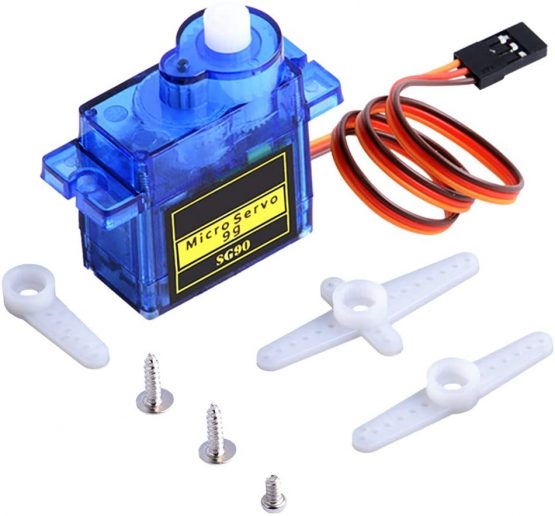

- #High torque servo motor arduino how to#
- #High torque servo motor arduino update#
- #High torque servo motor arduino android#
- #High torque servo motor arduino software#
- #High torque servo motor arduino code#
The cause was not using the Bluetooth module. Regardless of the commands for a particular position, it randomly changes its position. This one no longer recognized the position. It has failed quite easily – I have noticed some smoke being emitted during operation. The first failed servomotor was the one who turned the robot arm. Void controlServo4(uint8_t oldPos, uint8_t newPos) Void controlServo3(uint8_t oldPos, uint8_t newPos) Void controlServo2(uint8_t oldPos, uint8_t newPos) Void controlServo1(uint8_t oldPos, uint8_t newPos) Void controlServo0(uint8_t oldPos, uint8_t newPos) This is a demo with the robot arm controlled with PWM using the Adafruit’s driver.Īdafruit_PWMServoDriver pwm = Adafruit_PWMServoDriver()
#High torque servo motor arduino code#
I used the Adafruit_PWMServoDriver library and the inspiration to write the code was coming from examples provides by the library.
#High torque servo motor arduino update#
The driver uses an i2c-controlled PWM driver with a built-in clock and 12-bit resolution for each servo, that means about 4us resolution at 60Hz update rate. I used the Adafruit 16-Channel PWM/Servo driver to control all the five servos. Shaking and vibrations don’t occur in most of the servo positions, but the random rotations still continued. From the solutions found on the Internet, I used 470uF 50V electrolytic capacitor for each servo. This attempt turned out more successful than the previous one. I gave up the Servo2 library and I use capacitors and the Servo library. With five servos and only two pins with PWM that I can use, I tried another way to control the servo motors. I had two servo motors working well when I control them with PWM and that’s all. It can drive up to two servos using pins 9 and 10 on a standard board or 11 and 12 on a Mega. This is the Servo library distributed with Arduino 0016 and earlier.


Unlike DC motors, the PWM control is required for servos to determine the position rather than the speed of the servo shaft. The PWM pins are used for the control signal of servo motors. The biggest problem with Arduino UNO is that I have only two PWM pins (pin 9 and pin 10) that can be used with PWM while running the Servo2 library. The first attempt was to control the servo motors with the Arduino Sensor Shield V5. I used a digital multimeter to set an output voltage as close as 6V for the converter. Also, I have a power adapter (12V – 3A) to feed the converter. I used an adjustable LTC3780 DC buck/boost converter module. So an extra problem to be solved.Ī stable power supply of 6V as required for powering the servo motors is mandatory. These are making noise and running randomly while is working the Bluetooth connection.
#High torque servo motor arduino android#
The communication between the Android tablet running Blynk and the robot is done wirelessly using a Bluetooth connection.Īnd because I would not have had enough problems to solve, the Bluetooth connection interferes with the servo motors. In this project, I used the Blynk application to send commands to the robot. In this way, I reduced the number of degrees of freedom of the arm from 6 to 5. I replaced the SG90 servo motors with only one servo motor with metallic gearbox and claws. Because I need something different for my project, I cannot use the default configuration of the arm. I used this robot arm to build a robot waiter able to grab and handle a small plastic cup. Only two axes use the SG90 servo to move the end effector. From all of the 6 axes of the arm, four of them are actuated by the MG996R. The MG996R servo is the main servo motor used to move the SainSmart 6-axis robot arm. I want to describe you in details the solutions tried to control the servos, as well as the solution to smoothly control many hobby servos like MG996R while applying torque – in my case, the servo actuates a robotic arm. That is how I came to write this tutorial. If it is not controlled in the right way, the servos vibrate, make noise and rotate randomly. The servo changes its behavior under applying torque.
#High torque servo motor arduino how to#
But no matter how much was written on forums and blogs about how to control hobby servo motors like MG996R, almost all these tutorials provide information to control it while working freely, without applying torque. I know how hard is to produce great work and then put it out into the world. In addition, I write a section at the end of the article where I describe how I fix several MG996R servos and a conclusion.īefore going into the details, I want to tell you something. After reading this article, you should be able to control your hobby servos without noise or vibration.
#High torque servo motor arduino software#
I use PWM software and hardware resources because this is the right way to control one or more servo motors. In this tutorial, I provide enough level of depth to be informed about how to control servo motors with Arduino.


 0 kommentar(er)
0 kommentar(er)
